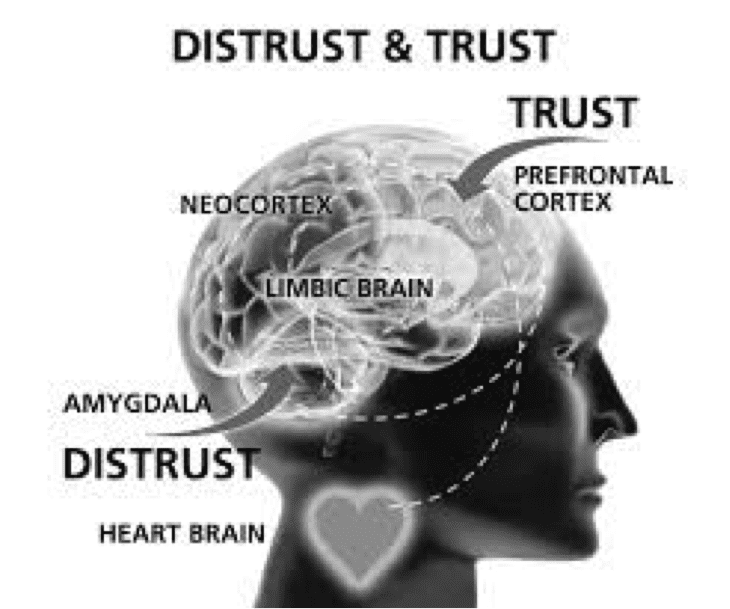Conversational Intelligence is the trademark of Judith Glaser. This article is based on a review of the book, Conversational Intelligence – How Great Leaders BUILD TRUST and Get Extraordinary Results by Judith E Glaser
What are conversations?
At face value our conversations are about talking, sharing stories and information, telling people what to do and what’s going on in our minds. However, conversations are the most common method of human interaction and, at an unconscious level, they can activate the two core human modes of behaviour, PROTECTION and CONNECTION. These modes are linked to our core needs; firstly to survive and secondly to continue the human race.
Conversations are dynamic interactions defining how we connect, engage and influence others – what we think, what we mean, what we say and how we feel during and after the conversation – are all key dimensions of that interaction.
Through improving our conversations we are able to enhance our relationships as well as having a more efficient and accurate way to assess whether a positive and fruitful relationship can be forged. For businesses the benefits are far reaching as improved conversations will enhance the culture of an organisation, improve the performance of its employees, reduce stress and so on.
So what is Conversational Intelligence?
The premise of Conversational Intelligence is:
‘To get to the next level of greatness depends on the quality of our culture, which depends on the quality of our relationships, which depends on the quality of our conversations. Everything happens through conversations’
By being more skilled and aware in how we conduct our conversations we are able to:
- Influence our neurochemistry, even in the moment
- Express our inner thoughts and feelings in ways that can strengthen relationships and success
- Influence the way we interpret reality
So how do conversations work?
There are three levels of conversation:
Level I: Transactional
Transactional conversations involve ‘Tell and Ask’ interactions. People exchange information, updates and facts that enable us to confirm where we each stand and what is on our minds. Trust is not important in such conversations as the focus is on the information and getting what is needed from each other.
Level II: Positional
Positional conversations involve ‘Advocate and Inquire’ interactions. One person advocates what they want & inquires about the other’s beliefs in order to influence the other to their viewpoint. Trust is conditional in such conversations depending on whether there is a fear of unfairness or misalignment.
Level III: Transformational
Transformational conversations involve ‘Share and Discover’ interactions. Through sharing inner worlds – thoughts, ideas and feelings – this signals a willingness to be influenced with the intention to co-create and innovate. High levels of trust exist in such conversations.
Understanding the Neuroscience behind conversations:
When we engage in conversation, at an unconscious level, before we have any conscious thought, feelings of distrust or trust are triggered automatically by the brain. Each of these responses has a completely different impact on the way we are able to interact, engage and connect with the other person which, in turn, leads to completely different outcomes from the conversation.
Distrust
If a conversation turns into a battle, or activates the fearful distrust state in some way, this triggers the protective mode activating the instinctive responses of ‘fight, flight, freeze or appease’ to ensure we survive. This results in the following neurochemical reactions:
- Higher levels of cortisol close down our pre-frontal cortex so we are no longer open to influence
- Higher levels of testosterone make us more aggressive & induces us to fight
- Higher levels of norepinephrine cause us to think more negative thoughts (this increases our mindset to ‘fight’ rather than ‘connect’)
In addition, memories are triggered in the limbic area of the brain such that the current situation may resonate with similar experiences in the past, enabling us to create a ‘movie in the mind’ for the current situation which may be far from the reality.
The overall impact of the above responses is that we get ‘stuck’ in our own point of view and become ego-centric. Also, as the pre-frontal cortex is not functioning fully we are less able to have good judgement, be strategic, connect and be open to influence making it difficult to collaborate and co-create at any meaningful level.
Trust
When a conversation makes us feel safe and comfortable with someone, it activates the ‘trust’ state and this triggers the connection mode activating the instinctive responses of wisdom, innovation, strategy or empathy allowing us to bond and grow. This results in the following neurochemical reactions:
- Higher levels of dopamine (happy hormone) gives us a positive outlook, making us feel good, more talkative and excited
- Higher levels of oxytocin (bonding hormone) makes us feel closer to others, wanting to be with them & open with them
- Higher levels of serotonin also makes us feel good
Furthermore, sharing our inner worlds enables us to close the gap between what we are thinking and what others are thinking, enabling us to connect on common ground.
The overall impact of these responses is that we are open to opinions of others and this enables us to build societies, co-create, have good judgement, be strategic, regulate emotions, handle difficult conversations and disagree without conflict.
How do we raise our Conversational Intelligence?
The book provides a number of frameworks and practises for individuals, teams and organisations to develop the quality of their conversations in order to effect better outcomes including methods to restore trust, improve conversation skills and ways to identify and manage personal emotional triggers.
Other practises for creating better conversations, might include using CLEAN language and metaphors to enable each party to interpret conversations based on their own point of view or regular mindfulness exercises are these can help us manage our emotions in the moment & pause before choosing how we respond to a situation.
Next steps
When you are having a conversation, notice your own feelings and the feelings of others and ask yourself:
- What modes of human behaviour are at play?
- What could I do to move the conversation into a more collaborative space?
Do you have a tendency to protect or connect and how might that be having an impact on your relationships and interactions?

